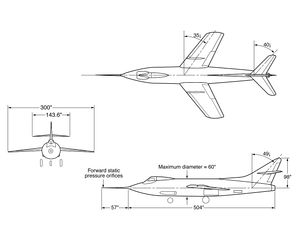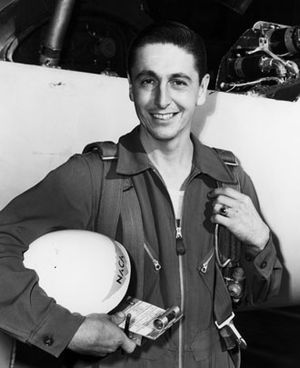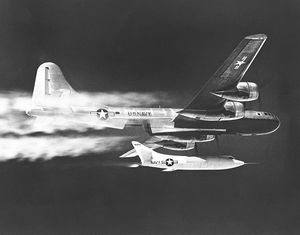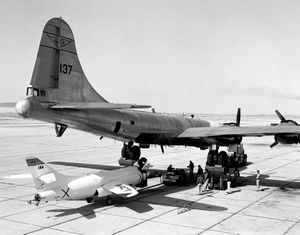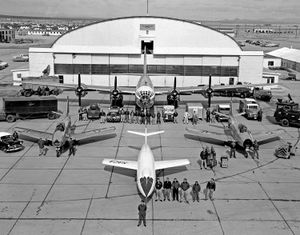First-Hand:The D-558-II Project - Chapter 6 of The Experimental Research Airplanes and the Sound Barrier
By David L. Boslaugh, CAPT USN, Retired
Design
The reader will recall that the Navy reprogrammed the funds originally intended for three more D-558-Is to be used instead for three new-design airplanes for phase II of the project - to be designated D-558-II. Soon after end of WW II hostilities a number of American aeronautics experts had been dispatched to Germany to determine the state of their aeronautical science, and they were amazed at the advances they found. In particular, the Germans had done considerable research on swept wing aircraft as a way of making wings seem thinner in an air stream, and thus having less drag as well as increasing their critical Mach number. This would allow the craft to fly faster before experiencing transonic buffeting. The Germans had even progressed to the point of having plans drawn up for a research airplane having wings that could be varied in sweep (on the ground) in order to test various sweep angles. This craft was to be designated the Messerschmitt P.1101. The visiting experts became convinced that the swept wing concept was deserving of further research, and the Navy’s Bureau of Aeronautics decided in 1945 to use the reserved funds for a swept wing research airplane. [19 pp.75-76]
The August 14-17, 1945 D-558 mockup conference between Douglas Aircraft, NACA, and the Navy started the ball rolling for the D-558-II. [19, p.76] In the original concept the plane would be powered by a combination of turbojet and rocket engines. The plane would be able to take off from the ground without the services of a mother plane and the rocket would be lit at research altitude to provide the additional 6,000 pounds of thrust needed for supersonic flight. In an unusual arrangement, the rocket engine would be mounted in the tail to fire rearward, and a Westinghouse J34-40 turbojet engine would be mounted further ahead in the fuselage. The turbojet engine tailpipe would be canted downward to exhaust through the bottom of the fuselage. [33, p.6, 8]
The Navy issued a contract on 27 January 1947 for three D-558-IIs. The wings would be swept back at a 35 degree angle, and would use a NACA 10% thick airfoil shape. The phase II structure would be similar to the phase I Skystreak. One tenth-inch thick magnesium alloy would form the fuselage skin, and the wings and tail would be of aluminum alloy. As in previous research airplanes, all flight controls would be manual without power boost, and the pilot would have a high-leverage control yoke instead of a center stick. The horizontal stabilizer would be mounted mid way up the vertical stabilizer, and would be electrically actuated to provide pilot-controlled variable incidence. As with the phase I airplanes, the nose section would be jettisonable for pilot escape. As with the X-1s, 400 air pressure measurement holes would be drilled in wing and tail surfaces. [33, pp.10-11]
Ground Launch
On 10 December 1947 D-558-II No. 1 was ready to be trucked to Muroc; minus its Reaction Motors XLR-8-RM-2, the navy designation of the Air Force XLR11 engine. The rocket engine had fallen behind schedule, and was not really needed for initial Douglas flight testing which would use turbojet power only. Douglas test pilot John F. Martin made the first turbojet powered flight on 4 February 1948. Martin would make approximately 20 flights in No. 1, and one of his principal findings was that with the turbojet engine only the craft was seriously underpowered. Douglas engineers decided to augment the engine with Jet Assisted Takeoff (JATO) units mounted in the rocket compartment. The word “Jet” in this context is a little misleading because the units were actually one-time solid rocket bottles. [52, pp.61-63 ] In September 1948 John Martin was promoted to Douglas chief test pilot, and veteran Douglas test pilot Eugene May, who was conducting Skystreak (D-558-I) tests at Muroc, took over testing Skyrocket No. 1. During his second flight, on 17 September, May achieved Mach 0.945 in a dive.
In October 1948 the second Skyrocket, also having a turbojet engine only, was delivered to Muroc, and test pilot May made two checkout flights on the second and seventh of November. The plane was then turned over to the Muroc Flight Test Unit, and NACA pilot Robert A. Champine made the first NACA D-558-II flight on 24 May 1949. Between 24 May 1949 and 6 January 1950. Champine and NACA pilot John H. Griffith would make 21 stability and control evaluation flights in the number two turbojet powered Skyrocket. During two of those flights, on 8 August 1949 (Champine) and 1 November (Griffith), while making high g, high angle of attack turns, the nose of the craft suddenly and uncontrollably shot up flipping the plane into a violent stall. They had encountered a new aerodynamic phenomena which would be called “pitch-up.” Later investigations in the Phase II series would reveal that the cause of pitch-up was the placement of the horizontal stabilizer relatively high on the vertical stabilizer. This could cause the horizontal stabilizer to enter the region of downwash from the wings at high angles of attack near the stall angle. The downward push would be just enough to suddenly elevate the angle of attack up to the stall point, and out of control. In a plane with low-mounted horizontal stabilizer the wing down wash impinges on the stabilizer at a low angle of attack range that is hardly felt and is nowhere near the stall angle. [19, pp.159-160]
At the end of December 1948 the third D-558-II, equipped with both rocket and turbojet engines, was delivered to Muroc. For the first time, they had a Skyrocket with both engines, and high speed testing could begin. Douglas pilot Eugene May made the first flight on 8 January 1949 using the turbojet engine only, and then on 25 January he made a familiarization flight using both engines. On his third flight, on 4 March, May made a takeoff with all four rocket chambers firing and turbojet at full RPM to find how quickly the ship could leave the runway. The result was gratifying, the ship needed less than a half mile of runway. On 24 June, on his tenth flight, May made a two-rocket takeoff with turbojet, and continued his flight until running out of rocket fuel. In the process, Skyrocket No. 3 was the first of the Phase II series to exceed the speed of sound. May would make three more flights, and then on the basis of what had been learned so far, ship number three was returned to the Douglas for modification to air launch configuration. [52, p.62] By early July 1949 a rocket engine had been installed in the number one Skyrocket to augment the turbojet, and on the 25th, May made the first takeoff in No, 1 using both engines. After this flight, Douglas pilot William B. Bridgeman would take over the bulk of D-558-II No. 1 flight testing. In all, Douglas would make 122 flights in Skyrocket No. 1, with the last flight on 14 August 1951.[33, p.13, pp.50-51]
Douglas engineers told the test pilots that, based on wind tunnel tests, the D-558-II could not be recovered from a spin. They warned the pilots to never let the plane get into a spin. However, on 25 January 1950, Bill Bridgeman met the spin monster while making low speed stall tests in Skyrocket No. 2; still equipped with turbojet engine only. In his book “The Lonely Sky” Bridgeman would write: “A wild lunge and she pitches up...” He realizes he has pushed her too far. Bridgeman goes on to describe how the Skyrocket fell in to a spin - that he has just been told is non-recoverable. Bridgeman proved the engineers wrong, and did manage to recover, but losing 7,000 feet in ten seconds. It is a good thing he started his stall tests at 20,000 feet. [4, pp.164-165] After that flight, the No. 2 plane was turned over to NACA for stability and control flight testing until June 1950. Then it was returned to the Douglas plant in Santa Monica for conversion to air launch configuration, removal of the turbojet engine, installation of the XLR-8 rocket engine, and installation of additional rocket propellant tanks in the volume vacated by the turbojet engine. [33, p.16, pp.52-53]
Air Launch
The results of the ground launch trials of Skyrocket No. 3 were disappointing, even with turbojet and rocket engines operating at maximum. The best speed that could be obtained when rocket fuel was exhausted was only a little over Mach 1, whereas the ship had been designed for higher speed. Furthermore, with takeoff speed at 150 mph and carrying a load of rocket propellants, an accident could end in a monstrous explosion. The Air Force and NACA had perfected the air launch technique for the X-1 series, and also demonstrated the rocket fuel economy of air launch. The answer seemed to rest in two factors: converting the Phase II craft to air launch, and removing the turbojet engine so that the vacated space and weight could be used for more rocket propellants. In the summer of 1949, NACA’s Director of Research Hugh Dryden recommended to the Navy Bureau of Aeronautics (BUAER) that two of the Phase II series be converted to air launch configuration. The air launch modification would mainly involve the installation of retractable bomb shackles in the top of the Skyrocket fuselage, He also recommended that at least one of the Skyrockets be converted to all-rocket propulsion. BUAER concurred and on 25 October 1949 modified the Douglas contract to convert the number two ship to all-rocket, air launch configuration, and the number three ship to air launch, but retaining the turbojet and rocket engines. Later the Navy would fund conversion of the number 1 Skyrocket to air launch/all rocket power. A few days later, No. 3 was taken back to Douglas to be converted to air launch configuration. [33, p.14, pp.19-20, 54]
The Air Force X-1 mother plane bomb bay modifications were unique to the X-1s and did not fit the Skyrockets form. Thus the Navy obtained a B-29 bomber from the Air Force to air launch the Skyrockets. As a navy aircraft, it was no longer a B-29, but was designated a P2B-1S, a patrol bomber classification. BUAER contracted with Douglas to lengthen and widen the bomb bay opening, including cutouts for the Skyrocket’s high-mounted horizontal stabilizer. In the bomb bay, two bomb release points were added to match the D-558-2 shackles, and fuselage sway braces were put in place. [19, pp.160-162]
By early September 1950, the No. 3 Skyrocket was back at the Douglas Mojave Desert facility on what was now called Edwards Air Force Base. On 8 September Douglas pilot William B. Bridgeman made first air launch of a Phase II; using the turbojet only. Bridgeman would make five more contract qualifying flights, and then turn the craft over to NACA on 15 December 1950. On 22 December, NACA pilot Albert Scott Crossfield made the first NACA flight in No. 3, for familiarization and instrument check. In this jet-and-rocket-propelled craft, Crossfield and NACA pilot Walter P. Jones began an investigation of the pitch-up phenomena; that would last from September 1951 mid 1953. The number three craft was fitted with a variety of wing modifications to determine their effect on mitigating pitch-up. In June 1954, Crossfield used Skyrocket No. 3 to begin a study of the performance effects of carrying externally mounted weapons and fuel tanks at transonic speeds. NACA pilots John B. McKay and Stanley P. Butchart completed the investigation of external stores, with McKay flying the final mission on 28 August 1956. In total, the number three Skyrocket made 87 flights, of which 66 were made by NACA pilots, most of which were combined rocket and turbojet powered. [33, pp.54-55]
The Number two Skyrocket, fitted with rocket engine only, was returned to Edwards in November 1950, and on the 26th, Douglas pilot Bill Bridgeman made its first rocket propelled air launch flight, achieving M 1.28. Between 26 January and 7 August, Bridgeman made 6 more flights, achieving M 1.85 on 23 June 1951. At this speed the ship began a violent oscillation, rolling uncontrollably 90 degrees from side-to-side causing Bridgeman to prematurely shut down the rocket engine. Bridgeman noted that his attempts to stabilize the ship with aileron motions only made the motions worse. He was out of phase with the motions and actually feeding energy into the wild oscillations. The best thing he could do was take his hands and feet off the controls. On 7 August, Bridgeman duplicated his previous flight but held the craft at a lower angle of attack (the pitch angle at which the plane meets the air stream). This resulted in less violent rolling oscillations and allowed him to get up to Mach 1.88 before shutting the engine down. He later adjudged the Skyrockets had enough fuel to achieve Mach 2, if the lateral oscillations could be controlled. On 15 August, Bridgeman made a new unofficial altitude record of 79,494 feet in the No. 2 craft. [4, p.256]
Douglas handed Skyrocket No. 2 over to the NACA High Speed Flight Research Station on 31 August 1951. The Station would make 75 more flights in No. 2 over a 63 month period, with Crossfield making the bulk of these flights. From 28 August 1951 to 5 August 1953 Crossfield would fly the aircraft 20 times to gather data on longitudinal and lateral stability and control, wing and tail loads, and lift, drag, and buffeting characteristics at speeds up to Mach 1.878. On 21 August USMC pilot LCOL Marion Carl took over Skyrocket No. 2 to make an unofficial altitude record of 83,236 ft. On 20 November 1953, Scotty Crossfield pushed the craft to Mach 2.005 in a slight dive, making him the first man to fly twice the speed of sound. It would be the only Mach 2 flight of the Phase II project. Following this Mach 2 flight, Crossfield and NACA pilots Joseph A. Walker and Jack McKay would fly No. 2 for such purposes as gathering data on pressure distribution, sound pressure levels, structural loads, aerodynamic heating, and dynamic stability. [33, pp.52-53]
In August 1951 Skyrocket No.1 was turned over to NACA after 122 Douglas flights. NACA put in storage until 1954, when it was taken back to Douglas to be converted to an air-launch rocket motor-only configuration, with the 6000 pound-thrust rocket engine. After that, No. 1 was flown only one more time, by NACA pilot Jack McKay on 17 September 1956. This was a shakedown flight of the air launch all rocket configuration, then the ship was retired. In addition to demonstrating that the D-558-II met contract specifications, the 123 flights of Skyrocket No. 1 enabled NACA to confirm wind-tunnel tests of the aircraft's characteristics. The comparisons were very close for speeds below Mach 0.85, but showed that above that speed, drag was less than wind tunnel predictions. The last flight in the program, and the last ever Skyrocket flight, would be flown in number 2 by Jack McKay on 20 December 1956. In total, 103 flights were made in number 2 [33 p.13, pp.50-51] This writer was privileged to be in the High Speed Flight Station control tower, and to be able to listen in to Jack McKay’s radio talk during that last flight.
The three Skyrockets provided considerable useful new information about swept wing airplanes at transonic and supersonic speeds. This included new knowledge on structural loads and heating at high speeds, the causes of, and modifications to alleviate the pitch-up phenomena, ways to alleviate transonic buffeting, the causes and fixes for roll coupling that tried to misalign aircraft with the air stream at high speeds, correlation of flight-measured lift and drag coefficients with wind tunnel data, and rocket exhaust effects on airplane stability. They also proved that manned airplanes could not only achieve Mach 2, but also survive. These findings were embodied almost immediately in the design of new high performance fighter aircraft. [68]
